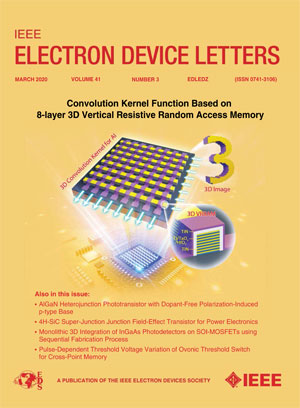Measuring Direct Flexoelectricity at the Nanoscale
IF 4.1
2区 工程技术
Q2 ENGINEERING, ELECTRICAL & ELECTRONIC
引用次数: 0
Abstract
Flexoelectricity is a property of all dielectric materials, where inhomogeneous strain induces electrical polarization. This effect becomes particularly prominent at the nanoscale where larger strain gradients can be obtained. While flexoelectric charges have been measured in mm-scale systems, direct measurements in nanoscale-thickness materials have not yet been achieved. Given that one of the most prominent applications of flexoelectricity is in nano-electro-mechanical systems (NEMS), confirming the presence and magnitude of the effect at these scales is essential. This study presents the first-ever measurements of flexoelectric-generated currents (direct effect) in nanoscale-thickness materials, using cantilevers with a 50 nm hafnium oxide layer. We confirm that the estimated flexoelectric coefficient from said measurements aligns with the values obtained from complementary experiments using the flexoelectric inverse effect. Additionally, by changing the cantilever geometry (modifying the width of the cantilevers), we demonstrate a 40% increase in the effective flexoelectric coefficient, explained by the interplay of different flexoelectric tensor components. These findings not only validate the presence of flexoelectric effects at the nanoscale but also open the possibility for full flexoelectric transduction of the motion in NEMS/MEMS devices.在纳米尺度上测量直接柔性电
挠曲电是所有介电材料的特性,其中不均匀应变引起电极化。这种效应在纳米尺度上变得特别突出,在纳米尺度上可以获得更大的应变梯度。虽然柔性电荷已经在毫米级系统中被测量,但在纳米级厚度的材料中还没有实现直接测量。鉴于柔性电最突出的应用之一是在纳米机电系统(NEMS)中,在这些尺度上确认这种效应的存在和大小是至关重要的。这项研究首次在纳米级厚度的材料中使用带有50纳米氧化铪层的悬臂梁测量挠曲电产生的电流(直接效应)。我们确认从上述测量中估计的挠曲电系数与使用挠曲电逆效应的互补实验中获得的值一致。此外,通过改变悬臂梁的几何形状(修改悬臂梁的宽度),我们证明了有效挠曲电系数增加了40%,这是由不同挠曲电张量分量的相互作用解释的。这些发现不仅验证了纳米尺度上挠曲电效应的存在,而且为NEMS/MEMS器件中运动的完全挠曲电转导开辟了可能性。
本文章由计算机程序翻译,如有差异,请以英文原文为准。
求助全文
约1分钟内获得全文
求助全文
来源期刊

IEEE Electron Device Letters
工程技术-工程:电子与电气
CiteScore
8.20
自引率
10.20%
发文量
551
审稿时长
1.4 months
期刊介绍:
IEEE Electron Device Letters publishes original and significant contributions relating to the theory, modeling, design, performance and reliability of electron and ion integrated circuit devices and interconnects, involving insulators, metals, organic materials, micro-plasmas, semiconductors, quantum-effect structures, vacuum devices, and emerging materials with applications in bioelectronics, biomedical electronics, computation, communications, displays, microelectromechanics, imaging, micro-actuators, nanoelectronics, optoelectronics, photovoltaics, power ICs and micro-sensors.
 求助内容:
求助内容: 应助结果提醒方式:
应助结果提醒方式:


